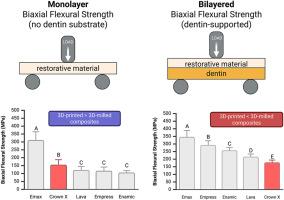Evaluating the biomechanical properties of 3D-milled and 3D-printed restorative dental materials
IF 3.5
2区 医学
Q2 ENGINEERING, BIOMEDICAL
Journal of the Mechanical Behavior of Biomedical Materials
Pub Date : 2025-09-13
DOI:10.1016/j.jmbbm.2025.107202
引用次数: 0
Abstract
Objective
The aim of this study was to evaluate the biaxial flexural strength (BFS) and modulus (BFM) of 3D-milled and 3D-printed restorative materials and assess their biomechanical behavior when bonded to dentin analog.
Materials and methods
Five dental material classes were tested: lithium disilicate glass-ceramic (Emax CAD), leucite-reinforced glass-ceramic (Empress CAD), polymer-infiltrated ceramic (Vita Enamic), 3D-milled resin-based composite (Lava Ultimate), and 3D-printed resin-based composite (Crown X). Disk-shaped specimens (n = 20, d = 12 mm, t = 1 mm) were fabricated. BFS and BFM were measured using biaxial flexural testing. Additional specimens were bonded to dentin analog (NEMA G10) and tested for BFS. Finite element analysis (FEA) evaluated stress distribution. Fractographic analysis used digital optical and scanning electron microscopy. Data was analyzed using one-way ANOVA and Weibull distribution (α = 0.05).
Results
Emax CAD exhibited highest mean BFS (312.71 ± 51.89 MPa) and BFM (41.30 ± 0.76 GPa), significantly superior to other materials (P < 0.05). Crown X demonstrated second-highest BFS (156.55 ± 30.88 MPa) but lowest BFM (10.77 ± 0.40 GPa). When bonded to dentin analog, BFS ranking changed: Emax CAD > Empress CAD > Enamic > Lava Ultimate > Crown X. FEA revealed materials with higher moduli retained stress within restoration, while lower modulus materials transferred stress to dentin analog. Weibull analysis showed Vita Enamic had highest Weibull modulus when bonded, indicating lowest variability, while Emax CAD showed lowest despite superior strength.
Conclusions
3D-milled lithium disilicate (Emax CAD) demonstrated superior mechanical properties and stress distribution. While 3D-printed composite (Crown X) showed promising strength when tested alone, performance significantly decreased when bonded to dentin analog.

评估3d研磨和3d打印修复牙科材料的生物力学性能。
目的:本研究的目的是评估3d铣削和3d打印修复材料的双轴抗折强度(BFS)和模量(BFM),并评估其与牙本质类似物结合时的生物力学行为。材料和方法:测试了五种牙科材料类别:二硅酸锂玻璃陶瓷(Emax CAD)、白石增强玻璃陶瓷(Empress CAD)、聚合物渗透陶瓷(Vita Enamic)、3d研磨树脂基复合材料(Lava Ultimate)和3d打印树脂基复合材料(Crown X)。制作盘状试样(n = 20, d = 12 mm, t = 1 mm)。BFS和BFM采用双轴弯曲试验测量。另外的样品与牙本质模拟物(NEMA G10)结合,并进行BFS测试。有限元分析(FEA)评估应力分布。断口分析采用数字光学和扫描电子显微镜。数据分析采用单因素方差分析和威布尔分布(α = 0.05)。结果:Emax CAD具有最高的平均BFS(312.71±51.89 MPa)和BFM(41.30±0.76 GPa),显著优于其他材料(P Empress CAD b> Enamic b> Lava Ultimate > Crown x)。FEA分析显示,高模量材料在修复过程中保留应力,而低模量材料将应力传递给牙本质模拟物。Weibull分析显示,Vita Enamic在粘合时具有最高的Weibull模量,表明最低的变异性,而Emax CAD虽然具有优越的强度,但具有最低的Weibull模量。结论:3d铣削的二硅酸锂(Emax CAD)具有优越的力学性能和应力分布。虽然3d打印复合材料(Crown X)在单独测试时显示出良好的强度,但当与牙本质模拟物结合时,性能显着下降。
本文章由计算机程序翻译,如有差异,请以英文原文为准。
求助全文
约1分钟内获得全文
求助全文
来源期刊

Journal of the Mechanical Behavior of Biomedical Materials
工程技术-材料科学:生物材料
CiteScore
7.20
自引率
7.70%
发文量
505
审稿时长
46 days
期刊介绍:
The Journal of the Mechanical Behavior of Biomedical Materials is concerned with the mechanical deformation, damage and failure under applied forces, of biological material (at the tissue, cellular and molecular levels) and of biomaterials, i.e. those materials which are designed to mimic or replace biological materials.
The primary focus of the journal is the synthesis of materials science, biology, and medical and dental science. Reports of fundamental scientific investigations are welcome, as are articles concerned with the practical application of materials in medical devices. Both experimental and theoretical work is of interest; theoretical papers will normally include comparison of predictions with experimental data, though we recognize that this may not always be appropriate. The journal also publishes technical notes concerned with emerging experimental or theoretical techniques, letters to the editor and, by invitation, review articles and papers describing existing techniques for the benefit of an interdisciplinary readership.
 求助内容:
求助内容: 应助结果提醒方式:
应助结果提醒方式:


